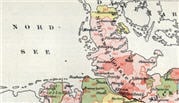Source Information

About Oldenburg, Germany, Marriage Records, 1876-1930
About this collection
This collection contains marriage records and name directories from Oldenburg covering the years 1876 up to and including 1920. Oldenburg is an independent city in the German state of Lower Saxony.
This university town is situated on the Hunte river about 31 miles west of Bremen and 34 miles south of the coastal town of Wilhelmshaven. Oldenburg, today the 3rd largest city in Lower Saxony, had its origins in the 7th and 8th century. It was first mentioned in a record from the year 1108. It was chartered in 1345. The city particularly flourished in the 17th century during the reign of Count Anton Günter. It has been, respectively, the capital of the County, Duchy, Grand Duchy, Free State and Region of Oldenburg. In order to distinguish it from Oldenburg in the state of Schleswig-Holstein, the official name of the city is Oldenburg in Oldenburg (Olbg).
In addition to the City of Oldenburg, this collection includes records from nearby rural communities as well as from Eversten, Ohmstede and Osternburg. The records sets cover varying time periods. Small rural communities at one time surrounded the city in all directions. In 1897, these were assigned to be part of either Ohmstede or Eversten.
Beginning on January 1, 1876, birth, marriage and death records in the former German Empire were created by local registry offices. The collected records are arranged chronologically and usually bound together in the form of yearbooks. These are collectively referred to as "civil registers." Complementary alphabetical directories of names may also have been created. While churches continued to keep traditional records, the State also mandated that the personal or marital status of the entire population be recorded.
What you can find in the records
Marriage records were created using preprinted forms that were filled in by hand by the registrar. Depending on the individual form or on the formulations used by the registrar, you may find:
- Sequential or Certificate Number
- Marriage Date
- Groom: Occupation, Given Names, Last Name, Denomination, Birthdate and Birthplace, Residence as well as details about his Parents and their Place of Residence
- Bride: Occupation, Given Names, Last Name, Maiden Name, Denomination, Birthdate and Birthplace, Residence/Address as well as details about her Parents and their Place of Residence
- Witnesses
- Signatures
The name directories are arranged alphabetically according to the last name of the bride and groom. They are generally bound as separate volumes covering several years each. They contain the following details:
- Last Names and Given Names of the Groom or Bride
- Cross-references to the marriage registry (number and year-range of registry)
More about using this collection
Each document has a front and back. These are displayed one ofter the other. Additional events from the life of the couple were sometimes recorded later on in the margins. These notes, sometimes referred to as "narration," can contain very useful information but they have not been indexed. As a result, information from the notes will not found via the search form. Under "Browse this collection,” select the Civil Registration Office and Year Range of the register desired. When name directories are available for a registry office, they are displayed and selectable at the end of the Year Range list. However, when a name directory forms part of a register itself, it can be accessed within that register by selecting the desired time period.
Updates:
04 Nov 2020: Added 11,343 new records for the years 1921-1930.
 Need help with the German language? Find
resources in our German Research Center.
Need help with the German language? Find
resources in our German Research Center.